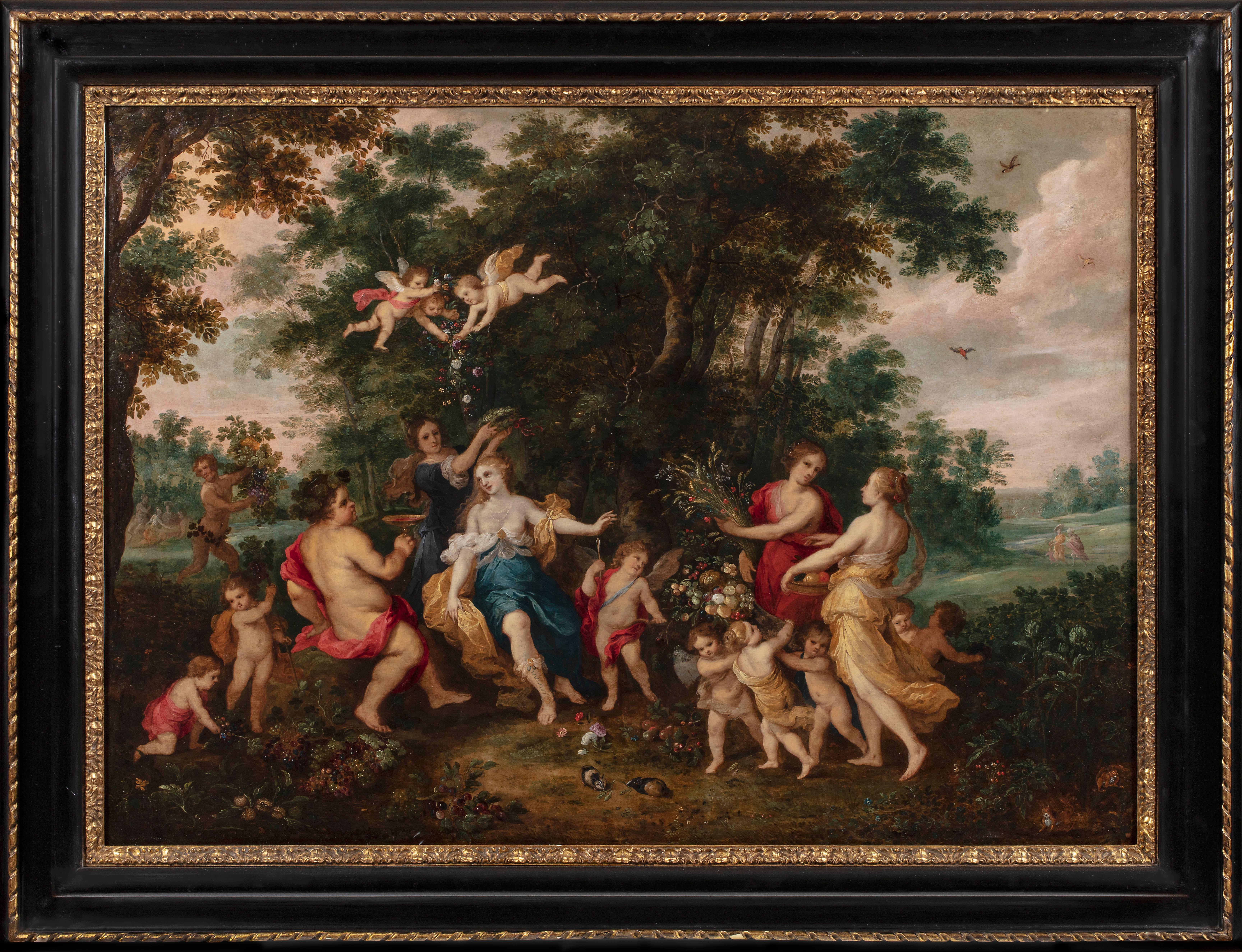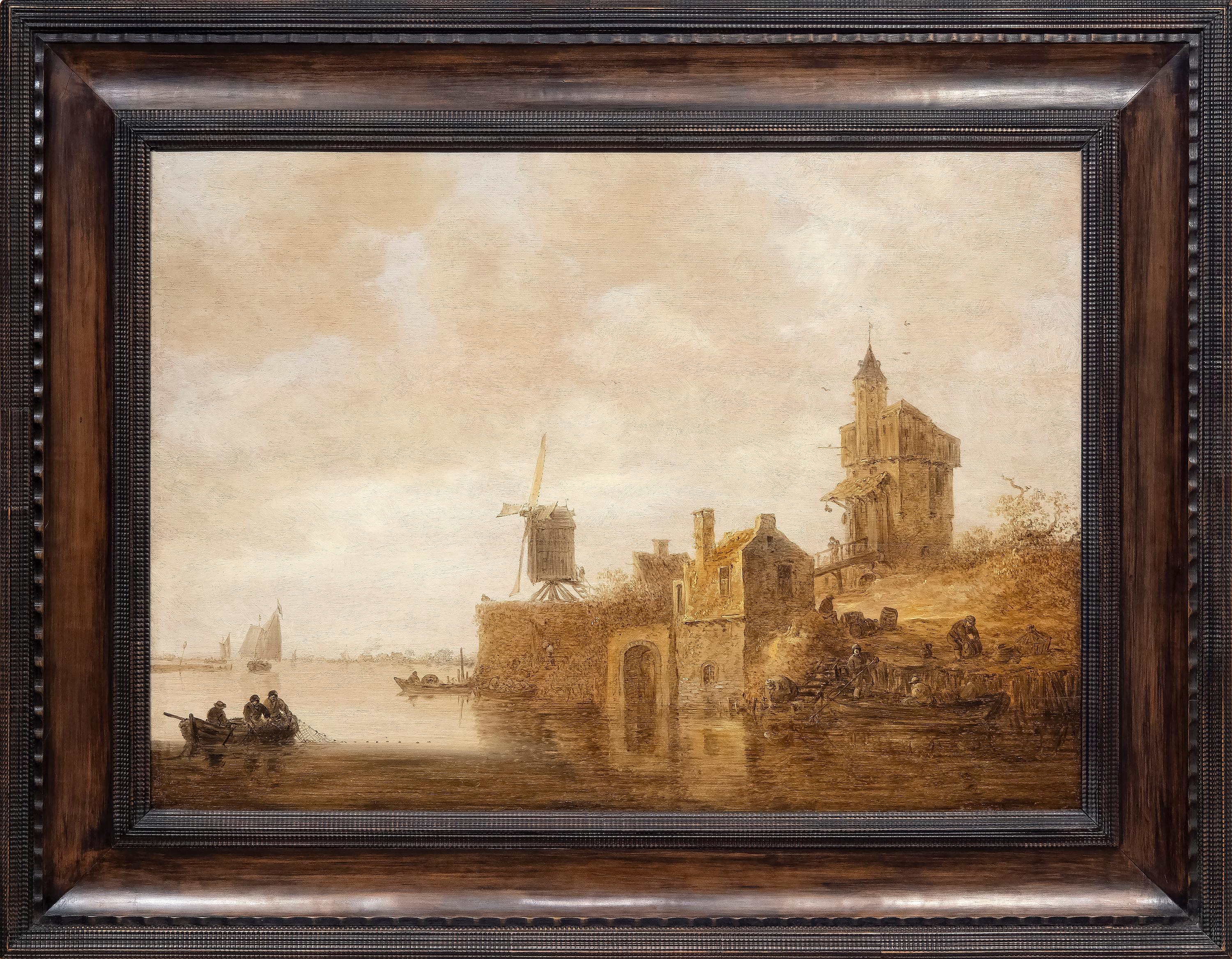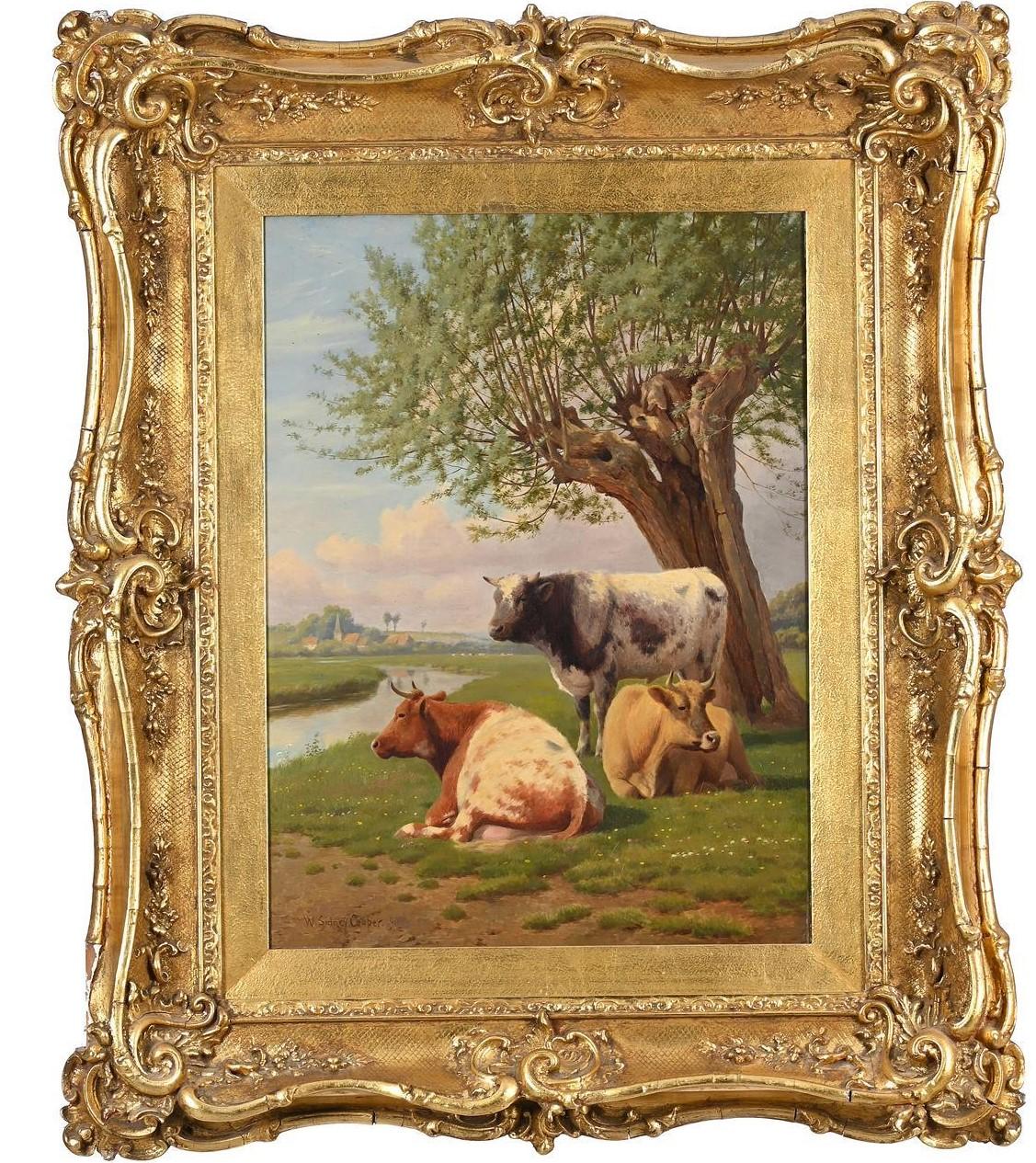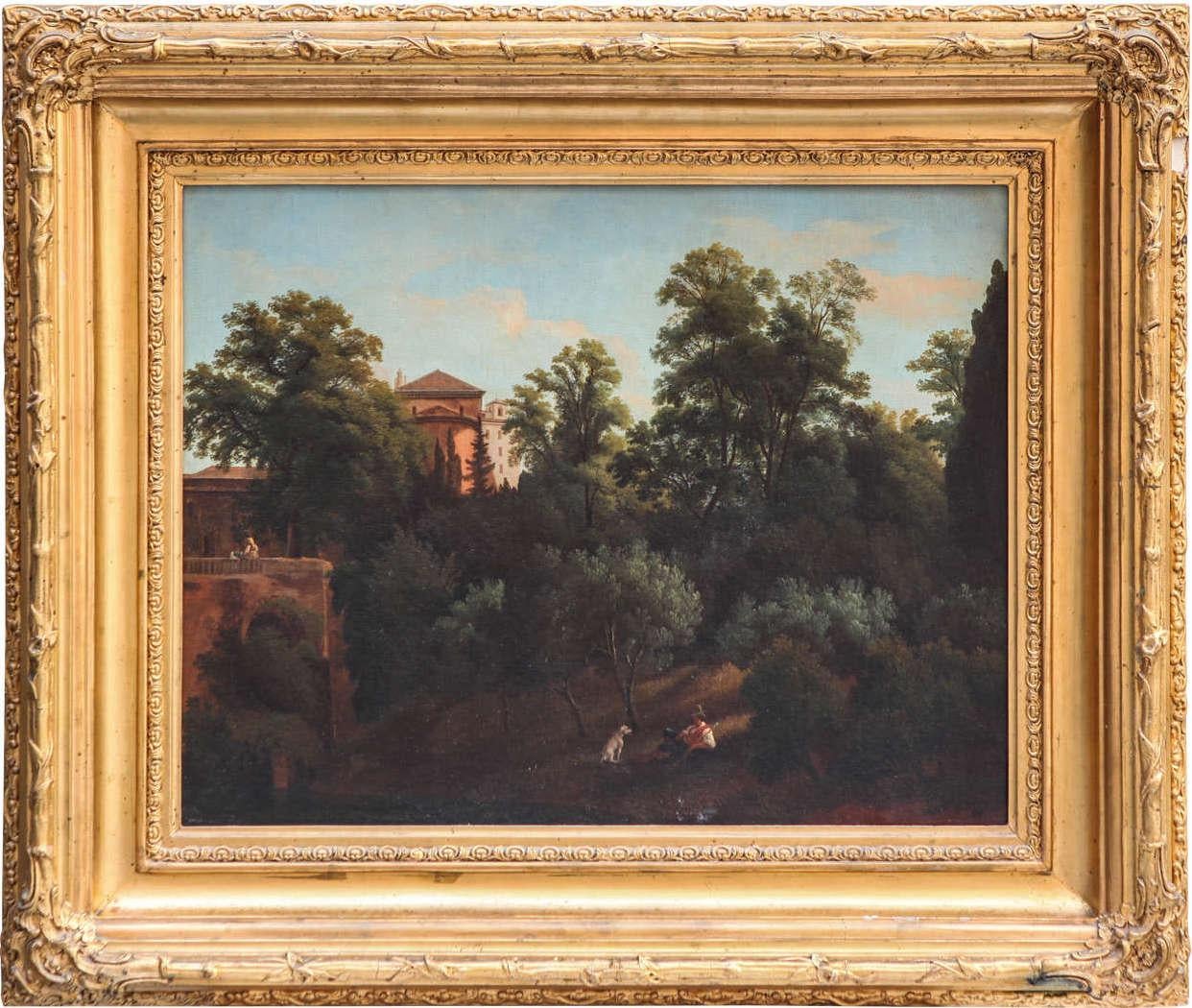Items Similar to Thomas Wijck Italian Landscape Paint Oil canvas Old master 17th Century Flemish
Want more images or videos?
Request additional images or videos from the seller
1 of 17
Thomas Wijck Italian Landscape Paint Oil canvas Old master 17th Century Flemish1650-1670
1650-1670
About the Item
Thomas Wyck or Wijck (Bewerwyck 1616- Haarlem 1677)
Roman landscape with washerwomen and apple seller
about 1660
Oil on panel - 35 x 47 cm., Framed 51 x 62 cm.
Provenance:
Bonhams Auction, London, Old Master Paintings 9.12.2015
Soraya Cartategui Fine Art Auction - Madrid / New York
The work is cataloged on the RKD archive (Rijksbureau voor Kunsthistorische Documentatie).
It is a work of the painter Thomas Wyck (Bewerwyck 1616 - Haarlem 1677), an important Flemish artist of the Golden Age, originally from the city of Haarlem and specialized in the creation of splendid landscapes and genre scenes, often set outdoors and populated by figures of commoners, as in our case with a couple of washerwomen who get water from a well and a woman who sells apples to a traveler.
Active in Rome between 1640 and 1642 - known here with the nickname of 'Flemish Thomas' - his style was strongly influenced by this Italian stay, and in particular by the contact with that group of Nordic painters, almost all Dutch, working in Rome in the full seventeenth century, called Bamboccianti. The proposed canvas is in fact part of the typical “bambocciate” trend, in the execution of which the echoes of the representations by the school leader Pieter van Laer, point of reference for this sought-after current of landscape architects, are captured.
In our work we find all the skill of the master Thomas Wijck who, thanks to his compositional style, allows us to open 'a window on everyday life' where small and lively scenes of popular life, treated with realism, become the protagonists.
The landscape around Rome is the typical context of his paintings, with these scenes of rural life set in the vast picturesque expanses of the countryside, dotted as in our case by perched villages or ancient ruins, without the great classical monuments.
The picture in question, on an oak support, may even have been painted during his stay in Rome, but also a realization made after his return from Rome to his native Haarlem, where he continued to paint Italian subjects for the next three decades.
The work is in good conservation conditions.
Certificate of guarantee and authenticity in accordance with the law.
For any information do not hesitate to contact us.
- Attributed to:Thomas Wyck or Wijck (Bewerwyck 1616- Haarlem 1677) (1616 - 1677, Flemish, Holland)
- Creation Year:1650-1670
- Dimensions:Height: 20.08 in (51 cm)Width: 24.41 in (62 cm)
- Medium:
- Movement & Style:
- Period:
- Condition:
- Gallery Location:Riva del Garda, IT
- Reference Number:1stDibs: LU98819908682
About the Seller
4.8
Platinum Seller
These expertly vetted sellers are 1stDibs' most experienced sellers and are rated highest by our customers.
Established in 2017
1stDibs seller since 2018
204 sales on 1stDibs
Typical response time: <1 hour
- ShippingRetrieving quote...Ships From: Riva del Garda, Italy
- Return PolicyA return for this item may be initiated within 7 days of delivery.
More From This SellerView All
- Coastal Landscape See Paint Lacroix de Marseille Oil on canvas 18th Century ArtLocated in Riva del Garda, ITCoastal view at sunset with fishermen and boats Atelier of Charles François Grenier De Lacroix, called de Marseille (Marseille 1700 - Berlin 1782) Oil on canvas 50 x 62 cm. - in fra...Category
18th Century Old Masters Paintings
MaterialsOil
- Children Landscape Jeaurat Paint Oil on canvas 18th Century Old master FrenchLocated in Riva del Garda, ITÉtienne Jeaurat (Vermenton 1699 - Versailles 1789) Game of children intent on harvesting grain (Allegory of Summer) Mid-18th century Oil on canvas 97 x 129 cm - Framed cm. 112 x 14...Category
18th Century Old Masters Paintings
MaterialsOil
- Van Uden Landscape Paint Oil on table 17th Century Flemish school Old master ArtLocated in Riva del Garda, ITLucas Van Uden (Antwerp 1595 - Antwerp 1673) Signed lower right: (Lucas v. ud...) Hillside landscape with pond oil on wood panel 34 x 54 cm, with frame 51 x 71 cm. Work published ...Category
17th Century Old Masters Paintings
MaterialsOil
- Van Den Bossche Alexander The Great Paint Oil on canvas 17/18th Century FlemishLocated in Riva del Garda, ITBalthasar Van Den Bossche (Antwerp, 1681 - 1715) Alexander the Great and Campaspe in the studio of the painter Apelles The canvas was exhibited in Perugia (Museo di Palazzo della Pe...Category
17th Century Old Masters Paintings
MaterialsOil
- Merry Company Party Duck 17th Century Paint Oil on canvas Flemish schoolLocated in Riva del Garda, ITJacob Duck (Utrecht, 1600 - 1667) attributable Merry company in an interior Oil painting on canvas 63 x 51 cm./ In antique box frame 80 x 70 cm. On the back of the old frame label...Category
17th Century Old Masters Paintings
MaterialsOil
- Storm See Water Landscape Vernet 18th Century Paint Oil on canvas Old masterLocated in Riva del Garda, ITClaude-Joseph Vernet (Avignon, 1714 - Paris, 1789) workshop of The Storm on the Lighthouse 1750/60 Technique: Oil on canvas Dimensions: 48 x 67 cm / framed 77 x 93 cm We share a highly pleasing work, a splendid marine executed by a talented painter from the workshop of the Frenchman Claude-Joseph Vernet, depicting a coastal view set in a Mediterranean port with the sea still stormy. The focal point of the composition is the large lighthouse at the entrance to the port, which, due to the power of the sea, was unable to bring to safety the ship that had crashed against the rocks, while the silhouette of a second sailing ship can be glimpsed in the distance. The canvas shows in full the pictorial, chromatic and narrative characteristics of the great master Vernet's coastal landscapes, characterised by the inimitable atmospheric conditions always hovering between darkness and light, storm and calm, instilling the observer with contrasting feelings, made even more intense by a palette of vibrant and highly contrasting colours. A similar composition, from which our author must necessarily have drawn, also attributed to the workshop of Claude Joseph Vernet is to be found in France, in Nantes, at the Musée d'Arts.  The effects of the light create a visual drama in the contrast between the darkness of the rain-laden storm clouds and the gash of clear sky that is opening up, pierced by the timid rays of light. The real magic of the painting is the painter's highly personal use of light and colour, with chiaroscuro effects that accentuate its three-dimensionality and movement. The compositional typology, as well as the quality of execution and attention to detail we are dealing with, are typical elements of the 'prototypes' conceived by the master, later taken up around the middle of the 18th century by his best pupils. Similar versions can be found in the most important international museums and private collections, belonging to a large series of paintings that the master created, together with his collaborators, during his stay in Italy. Vernet lived in Rome for twenty years (1734 - 1753), becoming particularly popular with English aristocrats who stopped there on their Grand Tour. International fame followed him from Rome to France, and to his English and French clients he added German princes...Category
18th Century Old Masters Paintings
MaterialsOil
You May Also Like
- Allegory of AbundanceLocated in New York, NYPainted in collaboration with Hendrick van Balen (Antwerp, 1575 – 1632). Provenance: Private Collection, Uruguay, since the 1930s. The eldest son of Jan Br...Category
17th Century Old Masters Paintings
MaterialsCopper
- A WolfLocated in New York, NYProvenance: The Marchesi Strozzi, Palazzo Strozzi, Florence Sale, Christie’s, London, May 20, 1993, lot 315, as by Carl Borromaus Andreas Ruthart...Category
17th Century Old Masters Animal Paintings
MaterialsPaper, Canvas, Oil
- River Landscape with a Windmill and ChapelBy Jan Josefsz Van GoyenLocated in Palm Desert, CA"River Landscape with a Windmill and Chapel" is a painting by Dutch Old Master Painter, Jan van Goyen. There are traces of a signature on the bow of the boat...Category
1640s Old Masters Landscape Paintings
MaterialsPanel, Oil
- Early oil depicting the Great Fire of LondonLocated in London, GBThe Great Fire of London in September 1666 was one of the greatest disasters in the city’s history. The City, with its wooden houses crowded together in narrow streets, was a natural fire risk, and predictions that London would burn down became a shocking reality. The fire began in a bakery in Pudding Lane, an area near the Thames teeming with warehouses and shops full of flammable materials, such as timber, oil, coal, pitch and turpentine. Inevitably the fire spread rapidly from this area into the City. Our painting depicts the impact of the fire on those who were caught in it and creates a very dramatic impression of what the fire was like. Closer inspection reveals a scene of chaos and panic with people running out of the gates. It shows Cripplegate in the north of the City, with St Giles without Cripplegate to its left, in flames (on the site of the present day Barbican). The painting probably represents the fire on the night of Tuesday 4 September, when four-fifths of the City was burning at once, including St Paul's Cathedral. Old St Paul’s can be seen to the right of the canvas, the medieval church with its thick stone walls, was considered a place of safety, but the building was covered in wooden scaffolding as it was in the midst of being restored by the then little known architect, Christopher Wren and caught fire. Our painting seems to depict a specific moment on the Tuesday night when the lead on St Paul’s caught fire and, as the diarist John Evelyn described: ‘the stones of Paul’s flew like grenades, the melting lead running down the streets in a stream and the very pavements glowing with the firey redness, so as no horse, nor man, was able to tread on them.’ Although the loss of life was minimal, some accounts record only sixteen perished, the magnitude of the property loss was shocking – some four hundred and thirty acres, about eighty per cent of the City proper was destroyed, including over thirteen thousand houses, eighty-nine churches, and fifty-two Guild Halls. Thousands were homeless and financially ruined. The Great Fire, and the subsequent fire of 1676, which destroyed over six hundred houses south of the Thames, changed the appearance of London forever. The one constructive outcome of the Great Fire was that the plague, which had devastated the population of London since 1665, diminished greatly, due to the mass death of the plague-carrying rats in the blaze. The fire was widely reported in eyewitness accounts, newspapers, letters and diaries. Samuel Pepys recorded climbing the steeple of Barking Church from which he viewed the destroyed City: ‘the saddest sight of desolation that I ever saw.’ There was an official enquiry into the causes of the fire, petitions to the King and Lord Mayor to rebuild, new legislation and building Acts. Naturally, the fire became a dramatic and extremely popular subject for painters and engravers. A group of works relatively closely related to the present picture have been traditionally ascribed to Jan Griffier...Category
17th Century Old Masters Landscape Paintings
MaterialsCanvas, Oil
- William sidney cooper, Cows by a river 19th century landscape oilBy William Sidney CooperLocated in York, GBA fine framed oil on canvas painting by the renowned artist William Sidney coope.Signed and dated 91 lower left. This painting depicts 3 cows resting by a river, a village with hous...Category
19th Century Old Masters Landscape Paintings
MaterialsOil
- 19th Century Roman Landscape oil on canvas with Giltwood FrameLocated in Rome, ITAmaizing 19' century Roman landscape depicting a part of Villa Borghese with Trinità dei Monti. With a finely carved gilt wood coeval frame. Measurements with frame cm 65 x78 wit...Category
19th Century Old Masters Landscape Paintings
MaterialsOil
Recently Viewed
View AllMore Ways To Browse
Antique Painted Italian
Old Weller Antique
Old Wellers Antique
Old Masters Painters
Old Masters Italy
Old New York City Painting
Old Couple
Small Old Paintings
Old Master Scene
Thomas Fine Art
Art Flemish
Thomas Maier
Old Woman Paintings
Antique Auctions
Auction Antique
Antique Art Creation
Oil Painting Thomas
Thomas Oil Painting





